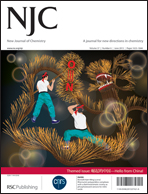Syntheses, photophysical, electroluminescence and computational studies of rhenium(i) diimine triarylamine-containing alkynyl complexes†
Abstract
A series of triarylamine-containing rhenium(I) diimine alkynyl complexes has been synthesized and some of their X-ray crystal structures have been determined. Low-energy transition bands at 402–444 nm were observed in the electronic absorption spectra and were tentatively assigned as an admixture of [dπ(Re) → π*(diimine)] metal-to-![[triple bond, length as m-dash]](https://www.rsc.org/images/entities/char_e002.gif) C−C6H4–R) → π* (
C−C6H4–R) → π* (

- This article is part of the themed collection: 崛起的中国—Hello from China!

 Please wait while we load your content...
Please wait while we load your content...